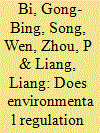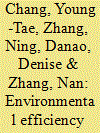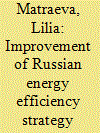|
|
|
Sort Order |
|
|
|
Items / Page
|
|
|
|
|
|
|
| Srl | Item |
| 1 |
ID:
150471


|
|
|
|
|
| Summary/Abstract |
Climate change is becoming an increasingly critical concern for human society. While there has been a great deal of research on climate change performance at the country/region level, our research focuses on the study of firm-level environmental efficiency as a proxy for firms' climate change management. Using a unique data set on U.S. S&P 500 firms for the period 2012–2013 and DEA slack-based models, we obtain firms' environmental efficiencies in six sectors. The results show significant performance dispersions both across and within the sectors. We highlight each sector's pros and cons in the environmental performance and propose guidelines for policy makers to further improve climate change performance. We also evaluate firms' operational performance and propose a unified performance measure by integrating operational and environmental efficiencies. Overall, we find there is no significant relationship between operational and environmental efficiencies in any of the six industrial sectors under study. The unified performance measures are more driven by the environmental efficiency than the operational efficiency.
|
|
|
|
|
|
|
|
|
|
|
|
|
|
|
|
| 2 |
ID:
128027


|
|
|
|
|
| Publication |
2014.
|
| Summary/Abstract |
Data envelopment analysis (DEA) has gained much popularity in performance measurement of power industry. This paper presents a slack-based measure approach to investigating the relationship between fossil fuel consumption and the environmental regulation of China's thermal power generation. We first calculate the total-factor energy efficiency without considering environmental constraints. An environmental performance indicator is proposed through decomposing the total-factor energy efficiency. The proposed approach is then employed to examine whether environmental regulation affects the energy efficiency of China's thermal power generation. We find that the environmental efficiency plays a significant role in affecting energy performance of China's thermal generation sector. Decreasing the discharge of major pollutants can improve both energy performance and environmental efficiency. Besides, we also have three main findings: (1) The energy efficiency and environmental efficiency were relatively low. (2) The energy and environmental efficiency scores show great variations among provinces. (3) Both energy efficiency and environmental efficiency are of obvious geographical characteristics. According to our findings, we suggest some policy implications.
|
|
|
|
|
|
|
|
|
|
|
|
|
|
|
|
| 3 |
ID:
121341


|
|
|
|
|
| Publication |
2013.
|
| Summary/Abstract |
In order to assess the environmental efficiency of power industry in China, this paper first proposes a new non-radial DEA approach by integrating the entropy weight and the SBM model. This will improve the assessment reliability and reasonableness. Using the model, this study then evaluates the environmental efficiency of the Chinese power industry at the provincial level during 2005-2010. The results show a marked difference in environmental efficiency of the power industry among Chinese provinces. Although the annual, average, environmental efficiency level fluctuates, there is an increasing trend. The Tobit regression analysis reveals the innovation ability of enterprises, the proportion of electricity generated by coal-fired plants and the generation capacity have a significantly positive effect on environmental efficiency. However the waste fees levied on waste discharge and investment in industrial pollutant treatment are negatively associated with environmental efficiency.
|
|
|
|
|
|
|
|
|
|
|
|
|
|
|
|
| 4 |
ID:
122736


|
|
|
|
|
| Publication |
2013.
|
| Summary/Abstract |
Many countries are worried about reducing energy consumption and environmental pollution while increasing the productivity and efficiency of their industries. This study intends to contribute to the literature by proposing a non-radial DEA model with the slacks-based measure (SBM) to analyze the environmental efficiency of China's transportation sector. The results show that most of the provinces in China do not have an eco-efficient transportation industry. The environmental efficiency levels in most of the provinces are lower than 50% of the ideal or target level. Therefore, China's transportation industry is environmentally very inefficient. China can reduce a great deal of carbon emissions in each province ranging from at least 1.6 million TOEs in Qinghai and at most 33 million TOEs in Guangdong and Shanghai.
|
|
|
|
|
|
|
|
|
|
|
|
|
|
|
|
| 5 |
ID:
153055


|
|
|
|
|
| Summary/Abstract |
The spatial distribution of population and economic activities has important impacts on both economic growth and the environment. This paper uses a slack-based measure to estimate the total factor environmental efficiency (TFEE) of 286 Chinese prefectural-and-above cities for the period 2002–2013. In particular, the relationship between city size and TFEE is investigated. The findings also show an inverted U-shaped relationship between TFEE and city size, which implies an optimal city size of 16.68 million residents in China. According to this estimate, most Chinese cities may be undersized due to the migration restrictions of the hukou registration system and, hence, suffer from great environmental efficiency losses. The estimated low average TFEE value of Chinese cities also suggests the large potential for efficiency improvement. Thus, government policies should focus on relaxing migration restrictions and encouraging the development of large cities.
|
|
|
|
|
|
|
|
|
|
|
|
|
|
|
|
| 6 |
ID:
094396


|
|
|
|
|
| Publication |
2010.
|
| Summary/Abstract |
Coal combustion, for the production of cement, generates considerable amount of environmentally detrimental carbon dioxide as an undesirable by-product. Thus, this paper aims at measuring environmental efficiency within a joint production framework of both desirable and undesirable output using Data Envelopment Analysis and Directional Distance Function. Carbon dioxide is considered as an input in one context and as an undesirable output in the other with the environmental efficiency being defined accordingly. Using 3 digit sate level data from the Annual Survey of Industries for the years 2000-2001 through 2004-2005, the proposed models are applied to estimate environmental efficiency of Indian cement industry. Empirical results show that there is enough potential for the industry to improve its environmental efficiency with efficiency being varied across states. Results also show that Indian cement industry, if faced with environmental regulation, has the potential to expand desirable output and contract undesirable output with the given inputs. However, regulation has a potential cost in terms of lower feasible expansion of desirable output as compared to unregulated scenario.
|
|
|
|
|
|
|
|
|
|
|
|
|
|
|
|
| 7 |
ID:
161873


|
|
|
|
|
| Summary/Abstract |
Green growth has become a new direction for Chinese economic development in the 21st century. Indeed, sustainable agricultural development is particularly important in China due to limits on resources and the presence of the largest population in the world. In this paper, we propose a novel decomposition of the overall inefficiency into three components of technical, mix, and scale effects at aggregate level by allowing for desirable and undesirable outputs in a non-parametric framework. We empirically investigate economic and environmental performance associated with resource misallocation (represented by input/output mix) in Chinese agricultural sector across the 31 provinces over the period 1997–2014. Our results show that average overall inefficiency in Chinese agricultural sector is 9.13% during the sample period, which suggests there exists a 7.94% possible improvement for gross output value and 1.19% potential reduction for carbon emission. Moreover, we find inefficiency is mainly due to the mix effect that requires an improvement in reallocation of inputs and this may be related to the ongoing supply side structural reforms in China. We also present a dual model of by-production technology for shadow price analysis and report upward trended carbon abatement costs in Chinese agriculture.
|
|
|
|
|
|
|
|
|
|
|
|
|
|
|
|
| 8 |
ID:
162954


|
|
|
|
|
| Summary/Abstract |
Analysis of Russian energy saving potential and experience of implementation of energy efficiency policy in Russia at the present stage showed that the domestic economy has considerable potential energy savings, but their implementation requires intensifying the activities of the State in this area, particularly with regard to overcoming the identified reasons for the low efficiency of national economy. Government activities in the field of energy saving and energy efficiency in Russia was initiated in 2008 and a significant legal and regulatory framework was developed as a basis for it, however, despite the positive examples, the objectives set for energy intensity reduction are not being met, and the overall level of implementation of government interventions in energy efficiency in industries is insufficient. This paper proposes the author's approach to Russian energy efficiency strategy, which, based on international experience, sets out priorities for improving the energy efficiency policies.
|
|
|
|
|
|
|
|
|
|
|
|
|
|
|
|
| 9 |
ID:
186477


|
|
|
|
|
| Summary/Abstract |
The most remarkable global climate agreement to date, the Paris Agreement of 2015 requires all countries to set emissions-reduction commitments. However, experts say that the pledges are not enough to prevent the global average temperature from rising 1.5 °C. This study adopts the Paris Agreement as a quasi-natural experiment and evaluates its policy intervention on environmental efficiency as well as GHG emissions in 162 countries from 1990 to 2020. We applied a global Malmquist-luenberger productivity (GML) index to measure global environmental efficiency. Moreover, we used seven major sources of GHG emissions to develop a comprehensive indicator of environmental degradation using the Principle Component Analysis (PCA). Results showed that developed countries experienced an increase in environmental efficiency, whereas developing and least developing countries (LDCs) showed decline. Technological progress was the key component of environmental efficiency in developed countries, while technical efficiency was the main indicator in developing countries and LDCs. Results of fuzzy regression discontinuity analysis documented that the policy intervention of the Paris Agreement was conducive to the global environmental efficiency by reducing the level of GHG emissions. However, the implementation of the Paris Agreement exerted heterogeneous effects on environmental efficiency with developed countries relatively experienced more profound effect.
|
|
|
|
|
|
|
|
|
|
|
|
|
|
|
|
| 10 |
ID:
096231


|
|
|
|
|
| Publication |
2010.
|
| Summary/Abstract |
A growing awareness of environmental quality has placed increased pressure on China to improve environmental protection and regulations in the country. How have the regional economies in the country performed in terms of environmental efficiency? The answer to this question is yet to be explored in the case of China. The objective of this paper is to present a quantitative analysis of environmental performance in China's regional economies and to examine the determinants of regional variation in performance. The findings are used to draw policy implications for environmental protection and are helpful in the discussion of China's future sustainable development.
|
|
|
|
|
|
|
|
|
|
|
|
|
|
|
|
| 11 |
ID:
150667


|
|
|
|
|
| Summary/Abstract |
In the climate agreement reached in Paris on the 12th of December 2015, the participating countries agreed to provide information about their Intended Nationally Determined Contribution, and also to assess its fairness and ambition. This study contributes a transparent empirical econometric tool for such an assessment. It shows that, using a formal decomposition framework that uniquely disentangles the macroeconomic and other influences on emissions, effort sharing in global greenhouse gas reductions can be achieved in a way that promotes innovation and environmental efficiency to reduce emissions without interfering with the right of poor countries to catch up economically. Based on GDP projections by the IMF and the OECD in a sample of about 185 countries, it presents country level CO2 emission targets applicable as benchmarks to assess the adequacy and fairness of national contributions.
|
|
|
|
|
|
|
|
|
|
|
|
|
|
|
|
|
|
|
|
|